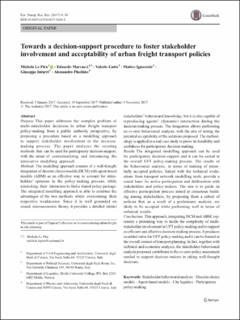| dc.description.abstract | Purpose: This paper addresses the complex problem of multi-stakeholder decisions in urban freight transport policy-making from a public authority perspective, by proposing a procedure based on a modelling approach to support stakeholder involvement in the decision-making process. The paper analyses the existing methods that can be used for participatory decision-support, with the intent of contextualizing and introducing the innovative modelling approach. Methods: The modelling approach consists of a well-thought integration of discrete choice models (DCM) with agent-based models (ABM) as an effective way to account for stakeholders’ opinions in the policy-making process, while mimicking their interaction to find a shared policy package. The integrated modelling approach is able to combine the advantages of the two methods while overcoming their respective weaknesses. Since it is well grounded on sound microeconomic theory, it provides a detailed (static) stakeholders’ behavioural knowledge, but it is also capable of reproducing agents’ (dynamic) interaction during the decision-making process. The integration allows performing an ex-ante behavioural analysis, with the aim of testing the potential acceptability of the solutions proposed. The methodology is applied in a real case study to prove its feasibility and usefulness for participatory decision-making. Results: The integrated modelling approach can be used for participatory decision-support and it can be casted in the overall UFT policy-making process. The results of the behavioural analysis, in terms of ranking of potentially accepted policies, linked with the technical evaluations from transport network modelling tools, provide a sound basis for active participation and deliberation with stakeholders and policy-makers. The aim is to guide an effective participation process aimed at consensus building among stakeholders, by proposing them a subset of policies that, as a result of a preliminary analysis, are likely to be accepted while performing well in terms of technical results. Conclusions: This approach, integrating DCM and ABM, represents a promising way to tackle the complexity of multi-stakeholder involvement in UFT policy-making and to support an efficient and effective decision-making process. It produces an added value for UFT policy-making and it can be framed in the overall context of transport planning. In fact, together with technical and economic analyses, the stakeholder behavioural analysis proposed contributes to the ex-ante policy assessment needed to support decision-makers in taking well-thought decisions. Keywords: stakeholder behavioural analysis, discrete choice models, agent-based models, city logistics, participatory policy-making | en_US |

